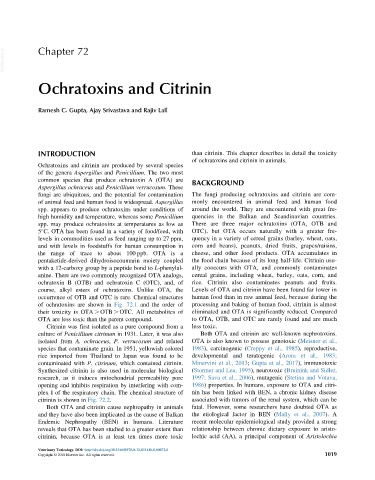Page 1087 - Veterinary Toxicology, Basic and Clinical Principles, 3rd Edition
P. 1087
VetBooks.ir Chapter 72
Ochratoxins and Citrinin
Ramesh C. Gupta, Ajay Srivastava and Rajiv Lall
INTRODUCTION than citrinin. This chapter describes in detail the toxicity
of ochratoxins and citrinin in animals.
Ochratoxins and citrinin are produced by several species
of the genera Aspergillus and Penicillium. The two most
common species that produce ochratoxin A (OTA) are BACKGROUND
Aspergillus ochraceus and Penicillium verrucosum. These
fungi are ubiquitous, and the potential for contamination The fungi producing ochratoxins and citrinin are com-
of animal feed and human food is widespread. Aspergillus monly encountered in animal feed and human food
spp. appears to produce ochratoxins under conditions of around the world. They are encountered with great fre-
high humidity and temperature, whereas some Penicillium quencies in the Balkan and Scandinavian countries.
spp. may produce ochratoxins at temperatures as low as There are three major ochratoxins (OTA, OTB and
5 C. OTA has been found in a variety of food/feed, with OTC), but OTA occurs naturally with a greater fre-
levels in commodities used as feed ranging up to 27 ppm, quency in a variety of cereal grains (barley, wheat, oats,
and with levels in foodstuffs for human consumption in corn and beans), peanuts, dried fruits, grapes/raisins,
the range of trace to about 100 ppb. OTA is a cheese, and other food products. OTA accumulates in
pentaketide-derived dihydroisocoumarin moiety coupled the food chain because of its long half-life. Citrinin usu-
with a 12-carboxy group by a peptide bond to L-phenylal- ally cooccurs with OTA, and commonly contaminates
anine. There are two commonly recognized OTA analogs, cereal grains, including wheat, barley, oats, corn, and
ochratoxin B (OTB) and ochratoxin C (OTC), and, of rice. Citrinin also contaminates peanuts and fruits.
course, alkyl esters of ochratoxins. Unlike OTA, the Levels of OTA and citrinin have been found far lower in
occurrence of OTB and OTC is rare. Chemical structures human food than in raw animal feed, because during the
of ochratoxins are shown in Fig. 72.1 and the order of processing and baking of human food, citrinin is almost
their toxicity is OTA . OTB . OTC. All metabolites of eliminated and OTA is significantly reduced. Compared
OTA are less toxic than the parent compound. to OTA, OTB, and OTC are rarely found and are much
Citrinin was first isolated as a pure compound from a less toxic.
culture of Penicillium citrinum in 1931. Later, it was also Both OTA and citrinin are well-known nephrotoxins.
isolated from A. ochraceus, P. verrucosum and related OTA is also known to possess genotoxic (Meisner et al.,
species that contaminate grain. In 1951, yellowish colored 1983), carcinogenic (Creppy et al., 1985), reproductive,
rice imported from Thailand to Japan was found to be developmental and teratogenic (Arora et al., 1983;
contaminated with P. citrinum, which contained citrinin. Minervini et al., 2013; Gupta et al., 2017), immunotoxic
Synthesized citrinin is also used in molecular biological (Stormer and Lea, 1995), neurotoxic (Bruinink and Sidler,
research, as it induces mitochondrial permeability pore 1997; Sava et al., 2006), mutagenic (Stetina and Votava,
opening and inhibits respiration by interfering with com- 1986) properties. In humans, exposure to OTA and citri-
plex I of the respiratory chain. The chemical structure of nin has been linked with BEN, a chronic kidney disease
citrinin is shown in Fig. 72.2. associated with tumors of the renal system, which can be
Both OTA and citrinin cause nephropathy in animals fatal. However, some researchers have doubted OTA as
and they have also been implicated as the cause of Balkan the etiological factor in BEN (Mally et al., 2007). A
Endemic Nephropathy (BEN) in humans. Literature recent molecular epidemiological study provided a strong
reveals that OTA has been studied to a greater extent than relationship between chronic dietary exposure to aristo-
citrinin, because OTA is at least ten times more toxic lochic acid (AA), a principal component of Aristolochia
Veterinary Toxicology. DOI: http://dx.doi.org/10.1016/B978-0-12-811410-0.00072-6
Copyright © 2018 Elsevier Inc. All rights reserved. 1019

